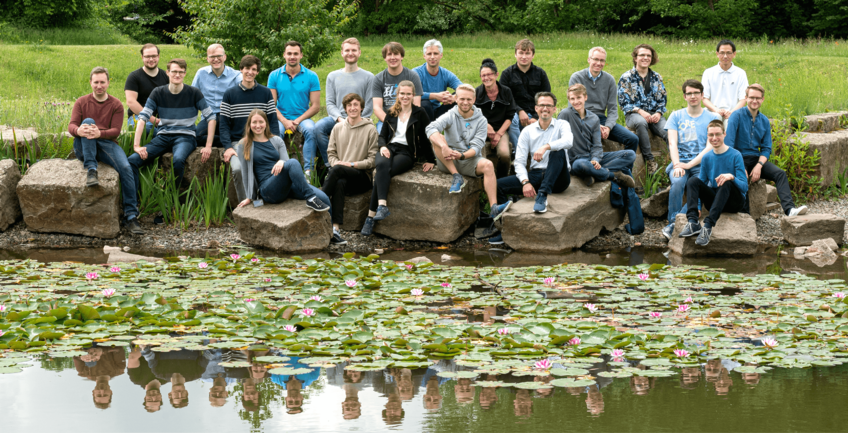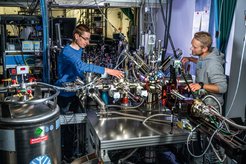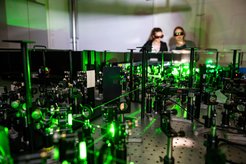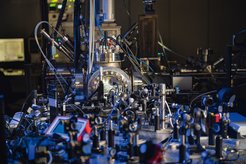
Research in quadrillionths of a second
Claus Ropers’ Department of Ultrafast Dynamics applies innovative methods to investigate electronic, structural, and magnetic processes in solids, nanostructures, and on surfaces. Variety to the daily laboratory life brings the team with a wide range of ventures and creative ideas.
When you enter the laser labs of the Department of Ultrafast Dynamics, it feels like stepping into a science fiction movie. In the room, there is a long table crowded with small apertures, mirrors, and lenses – a so-called optical table. Right next to it towers a two-and-a-half-meter high electron microscope. Then the lights go out, and everyone present puts on their safety goggles; the experiment begins. PhD candidate Germaine Arend and master student Jasmin Salome switch on a laser, its beam makes its way across the optical table and into the electron microscope. The path it takes was precisely determined by the physicists.

Together with other team members, the scientists headed by Ropers explore entirely new possibilities for electron microscopy. They are currently working on manipulating electron beams with light and precisely characterizing them. The department is thus building a bridge between electron microscopy and quantum technologies. Among other things, the goal is to develop novel measurement methods for the nanocosmos with drastically improved sensitivity and resolution.
In other experiments, short laser flashes selectively heat the surface of a solid so that its atomic structure abruptly remodels. At slightly staggered time intervals, electron flashes fire at the same spot, making the ongoing process visible to researchers.
Ultra-fast and ultra-small processes
With these experiments, the scientists investigate how solids and surfaces behave when they are brought out of equilibrium. This is because the processes that are crucial for the properties and functions of a material do not manifest themselves in a state of rest but only when a disturbance or reaction is induced. The particular difficulty here: The respective processes occur within quadrillionths of a second and within billionths of a meter.

Therefore, a main focus of the researchers is to develop and apply new experimental methods such as ultrafast imaging techniques. These are supposed to capture dynamic processes on their natural length and time scales. “With the electron flashes, for example, we can take snapshots of very fast processes that we trigger with current or laser pulses in a sample,“ Ropers explains. “When combining many of these images, we obtain high-resolution films in super slow motion that give us a precise understanding of the processes taking place.”
Faster, better, more precise
Especially in imaging ultrafast changes of state, the physicists made great progress with various methods. PhD candidate Till Domröse describes an example: “In the ultrafast electron microscope, we filmed, for the first time, how an insulator transitions into a metal, and we did so with a spatial resolution of nanometers and an exposure time of femtoseconds, which means one millionth of a billionth of a second.” In another experiment, the team succeeded in imaging magnetic switching processes with high spatial and temporal precision using extreme ultraviolet laser pulses. Such processes could be applied in future digital storage devices, like hard drives.
Foundations for future technologies

Information technologies and energy are ubiquitous topics of public discussion. Both areas require constant optimized solutions, which are, among others, provided by the fundamental research in Ropers’ team. “Our work deals with elementary steps of energy conversion on the nanometer scale, in nanostructures and on surfaces,” reports Armin Feist, project leader in the group. Initially, the focus lies on the fundamentals and understanding of microscopic processes. In the long term, however, the insights could lead to new approaches and alternative concepts for more efficient conversion processes.
“In the functional materials we are researching, we try to dramatically change specific physical and chemical properties of a substance within a very short time,” adds his colleague Murat Sivis, also a project leader in the department. For these processes as well, a wide range of applications are conceivable in the more distant future for developing “intelligent” nanoelectronics, such as nanosensors or chips, for example.
Camping, magic, and quiz shows
To celebrate their scientific successes but also awards, publications, or birthdays, the team always find new ways. Then they go out to eat together, organize barbecues, or make excursions. Before the pandemic, for example, the team regularly went on short camping trips, which they plan to finally resume this year.
During the celebrations, the team gives free rein to its creativity and designs unique mementos. That is why the wall in Ropers’ office is, among others, decorated with a board showcasing magic playing cards on which group members introduce themselves with their respective “magic powers”. On another occasion, they created a Monopoly version that is tailored to their work – Nanopoly. Probably a highlight of the department’s history took place at a recent barbecue. Ropers had to face the probing quiz questions of a Günther Lauch (note: Günther Jauch is the host of the German version of Who Wants to Be a Millionaire? “Lauch” means leek in German) as part of the game Who wants to be a Snack Bear?. “That really was a funny event! Our quizmaster even wore a carnival cap formed like leek during the game,” PhD candidate Felix Kurtz reports smirking. “And the boss did quite well with the questions about everyday laboratory life.”
Future neighbors
The about 25 members of the Department of Ultrafast Dynamics are rarely seen in the buildings of our institute, though. That is because their premises in the future Tower 7 on the Fassberg Campus have yet to be built. Until then, they will continue their research in the offices and laser laboratories of the IV. Physical Institute at Göttingen University.











